Few things are more exciting than planning your next RV adventure. But before you head out on the open road, there’s some legwork to be done – from mapping your route and deciding where to camp to packing and prepping your RV. And, if you’re planning to live in your RV (and maybe work in a travel trailer or motorhome) for an extended period of time, things can get even more complicated. Fortunately, we’ve got several tips for long term or full-time RV living.
Planning your route
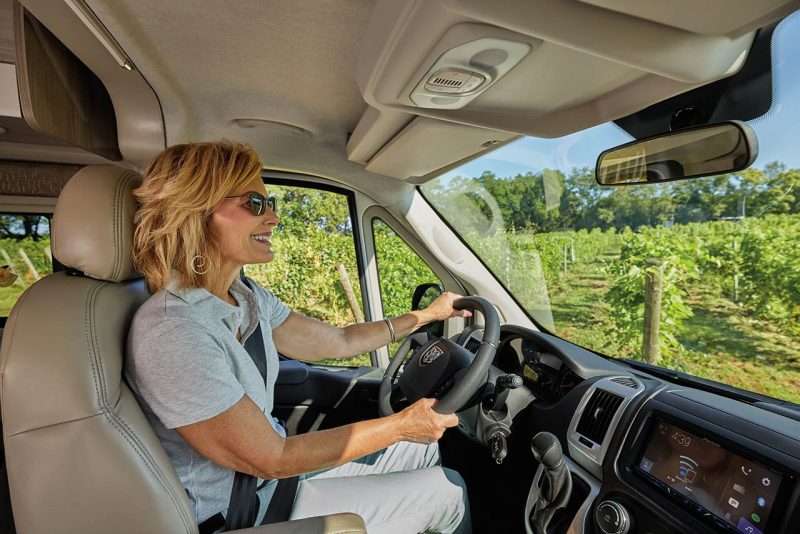
Start by planning your route. Knowing where you’re headed and which stops you’ll make along the way will help you stay on schedule, which is especially important if your long RV trip has a set end date. There are some great trip planning websites like gowandering.com and roadtrippers.com that can help you discover places to go, sites to see, and outdoor activities along your route.
Allow for flexibility and re-routing, too. You might really enjoy a destination and not want to leave on the day you planned to leave. Being flexible with your plan allows for more serendipitous experiences and adventures!
Additionally, if you plan on traveling to remote areas, you’ll want to make note of the next gas station and bring an atlas. It’s convenient to use your phone’s GPS or an external GPS, but in areas with limited/restricted cell coverage, paper maps are a must-have. If you prefer to use your phone, Google Maps has a download feature so you can save maps without using data. Just note that it will still drain your battery so if you rely on this, you’ll need to make sure you have cords and can plug into your RV or a backup power source.
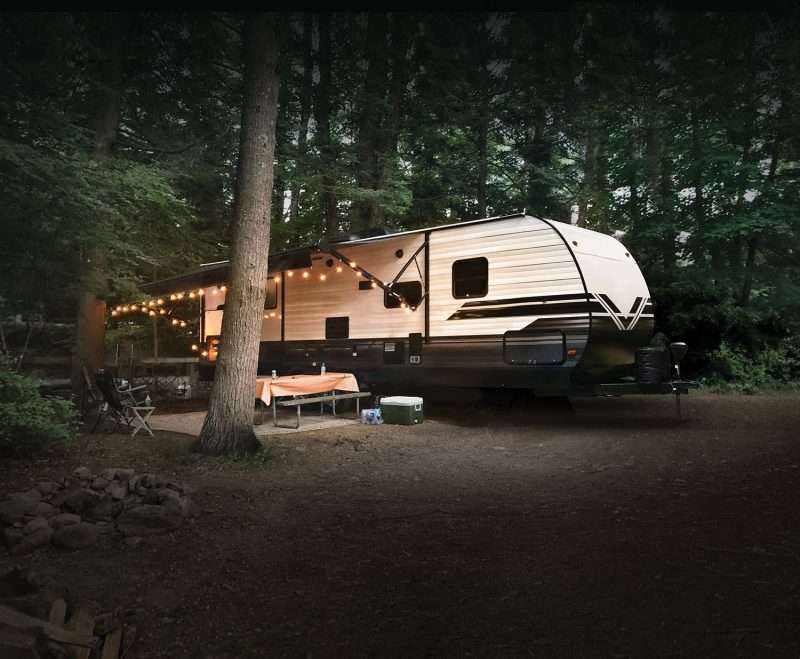
Wherever you go, try to arrive at your destination before the sun begins to set. Trust us, it can be a real challenge to locate and backup into an unfamiliar campsite with nothing but your tail lights to guide you after dark. Even if you have flashlights, it won’t make up for the difference between night and day (literally). And if you have trouble using the site hookups, there may not be any camp hosts around to ask for help.
Budgeting: full-time RV living isn’t cheap but it can be done on a budget
As with any vacation, it’s a good idea to set a budget for gas, food, activities, etc. on your long road trip. Setting a budget ensures you’ll have enough money for the things you need and some things you want. Sticking to your budget can also help you avoid going into debt while you travel.
There are several apps you can download to help you manage your money and save some. Mint is a free budgeting tool that allows you to set custom monthly budgets, spend tracking by category, and more.
Gas Buddy is a free app that lets you look up fuel prices so you can save some cash when filling up your tank. Most major gas station chains also offer fuel rewards programs and if you have a credit card that offers fuel rewards – or better yet cash back on all purchases – you can stack up the savings.
After gas, food is often one of the biggest expenses on any trip. Since dining out can get quite expensive, we recommend making at least some of your own meals in your RV’s kitchen. Many grocery stores have free apps where you can view current circulars and clip digital coupons. Some even offer curbside pickup for added convenience. You can save money and time if you do a little meal planning and order your groceries on the road. Or, skip the store and shop locally at farmer’s markets! You’ll get fresh picks of whatever is in season at affordable prices.
You might also be able to make money while you live in your RV by working remote. Lots of employers are offering more flexibility for their staff but if yours doesn’t, you can search for freelance work. With the right skill set and a reliable internet connection, you can make money from anywhere! Or consider picking up a seasonal or temp job; many tourist areas staff up for the busy season. If you do a little research, you might find a place that lets you stay nearby for free so you don’t have to shell out those hard earned dollars for a campsite. All these options can help pay for the costs associated with full-time RV living.
What to pack for your long RV trip
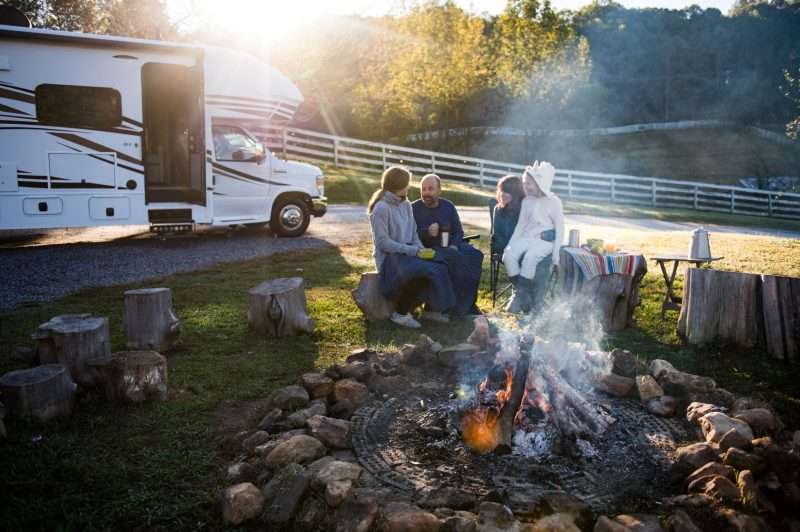
Figuring out what to pack for weeks or months on the road can be tricky. Especially if your RV travels will extend beyond a single season. You’ll want to pack enough to be comfortable and prepared for the weather but you’ve also got limited space in your RV. In my experience, it’s better to pack too much rather than too little. No one wants to re-wear dirty clothes or slip into still damp shoes. Consider what layers will be appropriate for the season and weather. If rain is in the forecast and you’ll be outdoors in it, grab a rain jacket and pants. And remember that temperatures can plummet overnight even in warm climates so layers are key.
To tackle this task, start creating your packing list as soon as possible! Keep a running list on your phone so whenever you think of something you’ll need, you can add it right away. Also, make note of things you’ll need to buy vs. things you already have and need to pack. Once you’ve identified items you need but don’t have, try to find them at your local thrift shop or off Facebook Marketplace. Also, Buy Nothing Groups (many areas have city-specific groups on Facebook) are a great place to source some items you don’t have. This will help your wallet and the planet!
- Categories of things to pack:
- Clothing and shoes
- Toiletries and personal items
- Kitchen/cooking items
- Bath items
- Pet supplies
- Hobby or craft supplies (for rainy days and downtime)
- First Aid / Emergency kit
- Tools for the road – It’s a good idea to have some of the basics like a wrench, drill, etc. because you might need them for setup or tightening anything that jingles loose. A wrench can help if you don’t have powered jacks, etc.
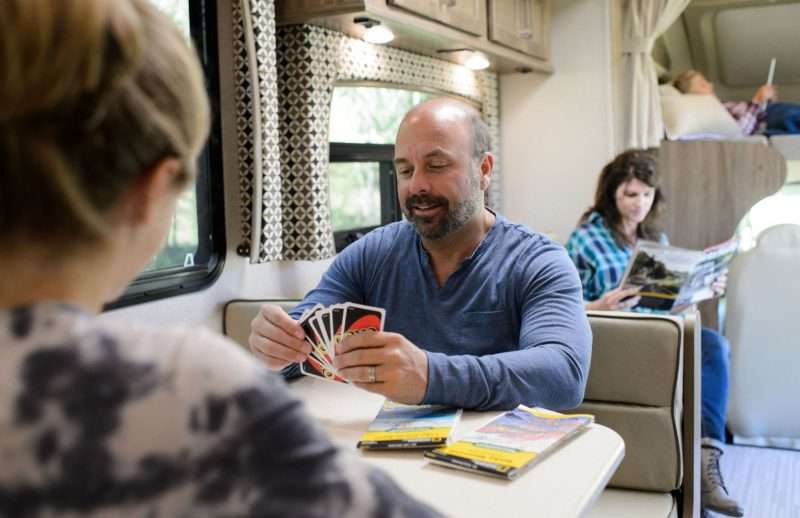
Organizing your RV for a long trip
After deciding what to bring on your long road trip, you’ll need to store it all. There are tons of tips, tricks, and packing hacks out there for organizing your RV.
Some are the same as what you’d do at home like using compression bags for bulky or off-season clothing. Some are specific to RVers: Use tension rods in your pantry to keep items in place. Alternatively, you can store food in plastic tubs before putting them on your pantry shelves. This keeps the food organized and keeps everything contained while driving. You can find these tips and many more on Pinterest.
Trying to find the “perfect” spot for all your items can seem overwhelming, especially if you’re new at this. We suggest putting everything away first and then slowly reorganizing as you get on the road. You’ll find systems that work for you.
Lastly, keep items you use frequently (phone, keys, wallet, etc.) in the same place so you always know where they’re at in your RV. Establishing a routine early on will help you keep track of those essentials throughout your trip.
Cooking and eating in your RV
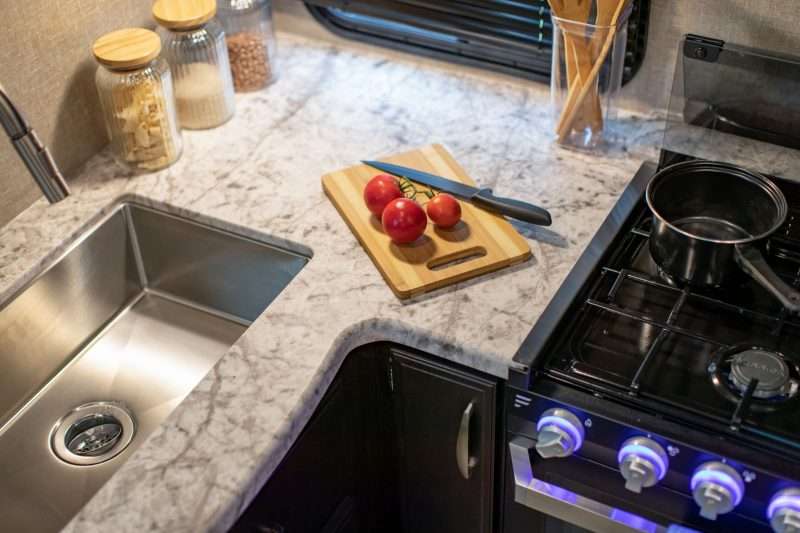
As we mentioned earlier, cooking meals in your RV can help you save money and time for other fun activities. Meal planning is an excellent way to make sure you have all the ingredients and cooking tools you’ll need to enjoy your meals while living in an RV. Even if your RV has a fully-equipped kitchen, simple or one-pot meals are the way to go. Clean up is easy!
If you’ll have access to electricity, a slow cooker or instant pot can be a great timesaver. Just prep your ingredients in the morning and set it to cook while you go exploring. You’ll come back to a delicious meal that’s almost completely hands-off. An added bonus to these cookers is that they generate little heat so you won’t have to crank up the AC after making dinner.
There are also several tools you can take to make great meals on the grill or over a campfire. Cast iron skillets and pie irons are extremely durable and versatile. You can make breakfast, lunch and dinner, plus desserts easily with both of these.
You can find several of our favorite recipes here, here, and here.
General safety advice for short-term and full-time RVing
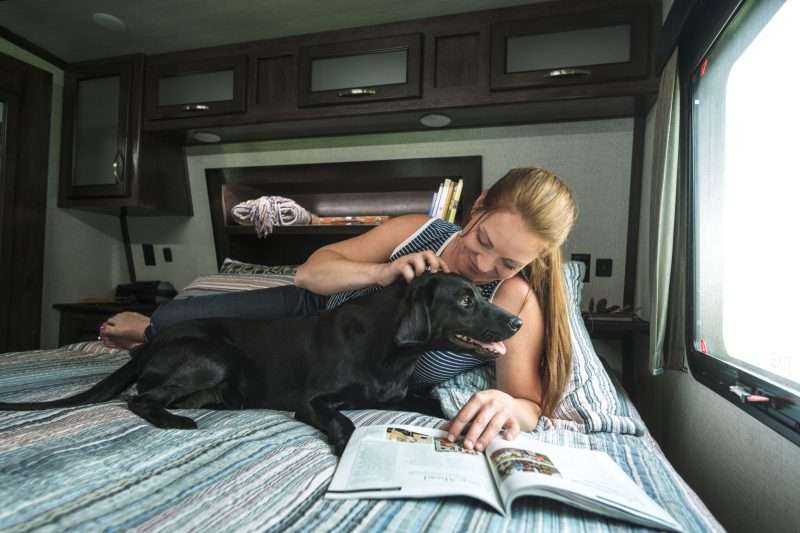
Regardless of where you’re going or how long you’ll be traveling, there are some general safety rules to follow.
- Always make sure someone knows where you are going and when you expect to return. Call or text a family member or friend and set dates to check in with them regularly during your road trip. Make a plan so they know what do if you miss a check in.
- Lockup any valuables and keep them out of sight when you park your RV or vehicle. Thieves like easy targets. If have an anti-theft alarm, make sure to set it every time you leave your vehicle – even if you’re just running to the bathroom or taking out the trash!
- These same rules apply for leaving your home alone for an extended period of time. Arrange for a house sitter and/or have someone check your mail so that your house looks occupied. Set security systems or cameras and make sure they’re working before you leave.
- Never leave your pets in your RV unattended and make sure they are up to date on all their vaccinations.
- Know what kinds of wildlife you might encounter on your adventures and how to avoid them.
- Bring a first aid kit everywhere you go.
Whether you’ll be traveling for a few weeks or a few months, a little prep work before your extended RV adventure begins can help you enjoy more of the journey with less of the worry.
This blog post is part of our Project Rustic series. Paige, the explorer behind Project Rustic, helped put together these helpful tips while planning for her six-month long RV trip. Stay tuned for more guest posts on our blog. Follow us on Facebook for exclusive content from Paige’s adventure across Michigan!